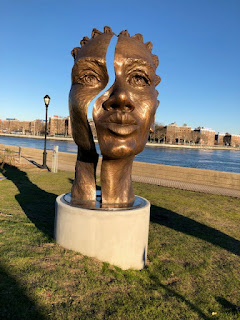The other day, I pedaled along the Queens and Brooklyn waterfronts from my apartment to the Williamsburg Bridge. After crossing, I turned onto Clinton Street and crossed the Lower East Side and Chinatown before crossing under the Manhattan and Brooklyn Bridges.
Then I decided to channel the bike messenger I was many years ago and zig-zag through the narrow steel, granite and concrete canyons of the Financial District. There, I did something that sounds riskier than it actually is (which is the opposite of so many things done in that part of town!): I stopped in the middle of Fulton Street, with a line of cars in front of, and behind, me.
It wasn't so dangerous because the traffic was halted for a bit longer than it normally would stop for a red light. Guys in thick boots and safety vests were doing some sort of construction or destruction, I'm not sure of which. So they, with the help of police, stopped traffic for a few minutes, did whatever they were doing and let the traffic go for another few minutes.
That was good, for me, because there are some things for which one should stop before entering.
I couldn't help but to feel that I was riding into the entrance of a cathedral--of tourism? Of capitalism? Of this city itself?
When the new World Trade Center tower was under construction, about a decade ago, I was prepared to hate it. I never cared much for the old "Twin Towers," but after they were destroyed in the September 11 attacks, I felt that nothing should be built in their place. I thought that the twin rays of blue light that were beamed up from the site for about a year were a fitting tribute to all of the lives lost.
I must say, though, that I like the new tower. Its curves on the outside give it the grace of a dancer rising and arching her arms as she pirouettes. It's as if the feeling of transcendence one feels under the arches of a cathedral were the result of the cathedral itself reaching for something.
I feel the new WTC, in its architecture, honors the people lost in and around the Twin Towers. If only they were here to see it.


























































